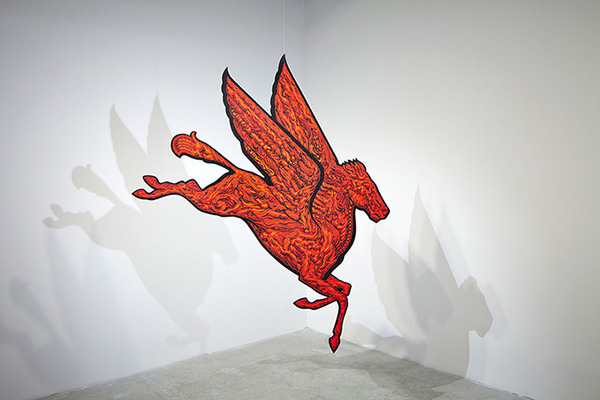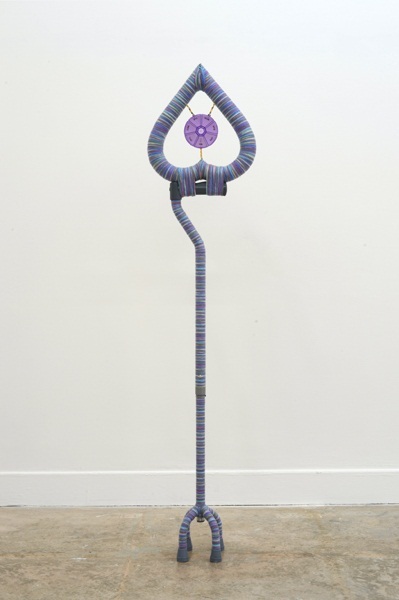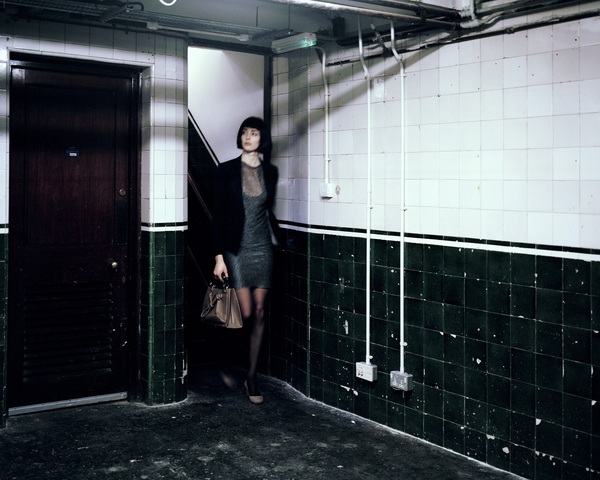There are two kinds of road trips: one where you have to get somewhere by a certain time (hotel, family reunion); and the other one where your plans are changeable (misfortune, curiosity). Both have equal ability to produce adventure and boredom, and though the adventure is what you end up taking home to friends and relatives, it’s boredom that’s your constant companion. Once the conversation in the car has died out, or your eyes have tired from reading, you fix your gaze on the horizon, as if your eyes were helping pull the car forward a little faster. As the day (or days) wear on and topographies change, you might find yourself looking to the sky more often than the land, since it is the only form of constancy in these quiet moments.
That constancy is the subject in much of Victoria Sambunaris’ work in Taxonomy of a Landscape, currently on at the Museum of Contemporary Photography. The exhibition presents several of Sambunaris’ large-scale, color photographs, taken on her travels across the United States, as well as a collection of diaries, journals, ephemera, snapshots and a short film.
Most of the photographs in this exhibition were shot where fragments of a mythology about the West still exist in the country – Texas, Utah, Montana, Arizona, Wyoming, and Alaska. There is an ambivalent relationship to the post-industrial landscape, especially since the industry in many of Sambunaris’ photographs is nascent or thriving. Her works Untitled (Wendover, Utah) and Untitled (Alaskan Pipeline at Atigan Pass, Brooks Range, Alaska) foreground some form of industrialization, but the images remain clean and distant, allowing the town or pipeline to be folded in with the natural geology.
![]()
Victoria Sambunaris, Untitled (Wendover, Utah), 2007, Chromogenic Print, Edition AP 1 of 2. 55 x 76 inches; Courtesy of the Museum of Contemporary Photography.
Alternately, her works Untitled (Tomato Pool, Yellowstone) and Untitled (Distant Steam Vents, Yellowstone) have the visual effect of a tailings pond at first glance, though on closer inspection, are amongst the few works in the show to bear no trace of human contact. This moment feels complicated, where the more pastoral beauty of the landscape is fractured by scars and stitches left by human enterprise, though it only foregrounds those imprints which have been invisible in earlier works by the photographers of the west, like Timothy O’Sullivan, Charles Weed, Ansel Adams and Edward Weston, who arguably defined some of those earlier taxonomies of the landscape.
In all of her works, however, her relationship to the sky is unwavering. It’s against the sky that all taxonomies are revealed, whether it’s a gorge, as in Untitled (Santa Elena Canyon, Big Bend National Park), or a container yard, as in Untitled (Red Containers, Wet Ground, Fort Worth Texas). The sky often takes up a third to half of the scene in Sambunaris’ images, and ranges from a pale azure to soft grey. In Untitled (Petrified Forest Near Holbrook, Arizona), pieces of petrified wood balance uneasily on top of piles of grey soil. The forest echoes the clouded sky above it, with the absence of the precarious balance that creates tension in the lower half of the composition.
Near the back of the first floor of the gallery, you are drawn into a dark annex. Here, the walls echo with large photographs of watery caves, laden with stalactites. In one corner, fragments of a video play on a loop – bits of footage filmed during Sambunaris’ travels over the past eleven years. In a glass case near the entrance are bits of ephemera collected by the artist on her many road trips; maps, tools, books, postcards, fossils, a horseshoe. The objects speak to a romantic image of traveling the United States – with much of it hearkening back to a mid-twentieth century sense of adventure, almost like props out of a Cormac McCarthy novel. In another glass case, selections from the artist’s road journals are displayed, which play into the aforementioned romanticism, as we get fragments of her story – a note from a hotel staff member, a business card for a local auto repair shop, a handbill advertising a deli local to some place called “Pony Expresso.” The journals themselves are written in a dense, manic scrawl with little clue as to the date or location they were written. Their relationship to you, as you peer down at them through the museum glass, establishes them as an archive; any document behind glass implies authority and wholeness – there is nothing that can be added or edited, nor can it be idly flipped through. You are prohibited from pursuing your curiosity further, which at another time and another place, is how facts are born. An in-gallery text explains, “Sambunaris says that she might wait as much as two weeks for the weather to change to provide the neutral and diffused light she prefers for her work.” This paints a solemn image of the artist, waiting out all sorts of weather, like a modern-day John of Patmos in a Poussin painting.
![]()
Victoria Sambunaris, Untitled (Alaskan pipeline at Atigun Pass, Brooks Range, Alaska), 2003, Chromogenic Print, Edition 3 of 5. 39 x 55 inches; Courtesy of the Museum of Contemporary Photography.
The whole show comes together so far as both an exhibition of an artist’s processes, but also as an exhibition of a nostalgia for a type of mythology that is fading from the collective American imagination. Route 66, that famous highway, was replaced nearly thirty years ago, and the idea of disappearing into the West, as described by beat poets, is now nearly impossible, since most adventurers have a mobile phone, laptop and Wi-Fi at nearly every pit stop on the road. The mythology of the American West is compatible with the 19th century concept of the sublime – a landscape so grand and overwrought that you are beholden to the scene, your sense of self crushed under looming mountains, angular cliffs, and raging streams. Once you have taxonomized something, you dissected, preserved, and categorized it. It is very possible that, in photographing oil pipelines and mountain highways, Sambunaris is lamenting both her own taxonomy, and that which is evidenced before her.
The deliberate narrative is broken when you reach the second floor. After gazing into the grand landscapes that Sambunaris has composed, and rifling through her personal effects, we are presented with what seems like the punch line – 1,566 4x5-inch color prints, a collage that spans the entire height and breadth of one of the museum walls. The constructed narrative of a lonely adventurer on long-forgotten American highways is broken, as the photographs reveal the soft side of an adventure – smiling friends, animals, children, puppies, shared drinks, dive-y motels, cowboys, gas stations, and landscape after landscape; Sambunaris’ travels do not seem as sublimely lonely as her larger works imply, and yet looking at this huge mural, the figure most prominent is still an unbroken, constant sky, the remnants of that great American mythology.
—Sarah Hamilton
[Image on top: Victoria Sambunaris, Untitled (Santa Elena Canyon, Big Bend National Park, Texas) , 2010, Chromogenic print, 55 x 76 inches; Courtesy of the Museum of Contemporary Photography.]

















